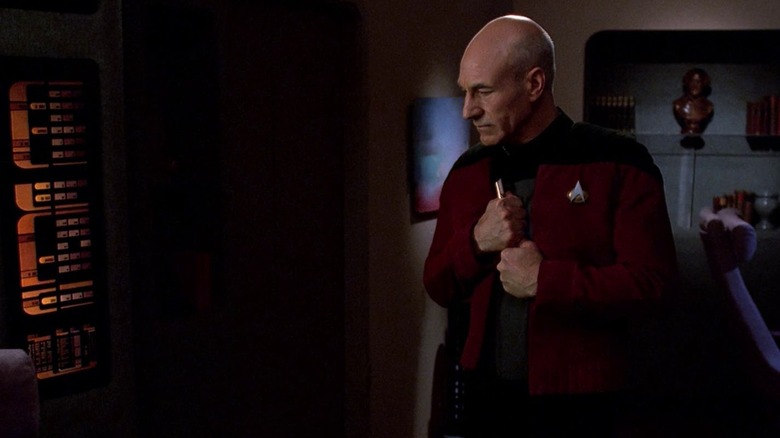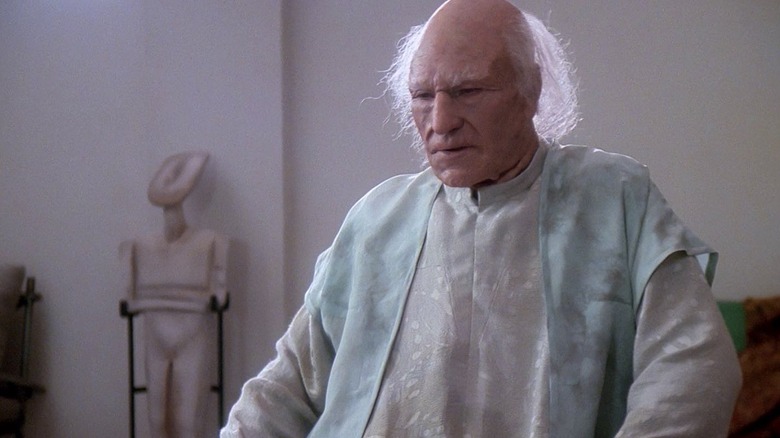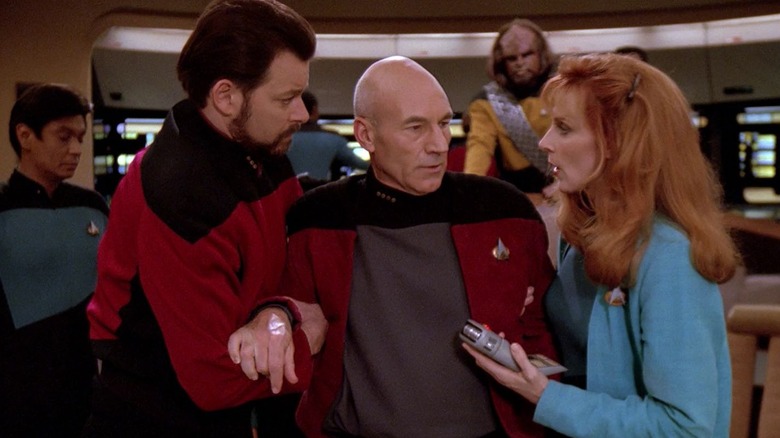Star Trek: TNG's 'The Inner Light' Episode Got An Unofficial Sequel By The Original Writer
In the "Star Trek: The Next Generation" episode "The Inner Light," the U.S.S. Enterprise is sailing through space when it happens upon a strange probe, unknown to its databases. The probe zaps Captain Picard (Patrick Stewart) in the brain, and he falls unconscious. Picard awakens on the planet of Kataan, and is told that his real name is Kamin, and that he is married to a woman named Eline (Margot Rose). Picard assumes he's been kidnapped, but can't figure out why.
Months pass, though, and Picard begins to accept that, yes, he actually is Kamin. He and Eline have kids and a loving family together. "Picard" vanishes from his memory. He masters the flute. He grows into a very old man. Kamin eventually dies in his 90s when Kataan is destroyed by an unavoidable natural cataclysm.
Back on the Enterprise, it's revealed that Picard is merely unconscious on the floor, and that he is hallucinating everyone on Kataan. He sits up, with only 25 minutes having passed. It's revealed then that Kataan actually went extinct generations ago, and that the probe was the last recording of its civilization. Picard was the last person to experience that kind of life. Picard returns to the captain's chair, but now with a whole new lifetime in his head.
"The Inner Light," written by Morgan Gendel, is often counted as one of the best "Next Generation" episodes, and is certainly one of its most emotional. It features one of Stewart's best "Star Trek" performances, and it won a Hugo award for Best Dramatic Presentation. It also, perhaps unexpectedly, had a sequel. Back in 2012, Gendel spoke with Forbes Magazine about how he penned a follow-up story to "The Inner Light," called (natch) "The Outer Light." Gendel originally published "The Outer Light" as a web comic, which can be read, in part, on the Treks In Sci-Fi website.
'The Inner Light' left Picard without any closure
The idea of a sequel to "The Inner Light" may strike some Trekkies as heretical. As mentioned, it's usually seen as one of the best episodes of the series, and ends on such a perfect, tragic note. Picard fell in love with a new life, and was allowed to retire, have a family, and lose himself in a new identity. The reveal at the end — that Kataan had been dead from the start — adds a painful pang of wistfulness.
But, at the same time, many Trekkies have felt a little uncomfortable at how momentous the story really was. Picard lived an entire life in his head, and the following week, went back to work as if nothing had happened. Gendel's sequel idea was to address that aspect of the story. He said in the Forbes interview that he saw Picard as the sole survivor of a legitimate holocaust, and that he was never granted any kind of dramatic development or necessary closure to accept that he had now lived two lives. Gendel's idea, however, was that Picard meet the real-life Eline, face-to-face. In actual reality Eline would never have met Picard, so their interactions would be awkward at best. As the writer put it:
"Well, I came up with the idea [for a sequel], but at the time they just said that they don't do sequels. So I didn't even get as far as pitching a sequel. That being said, all that my idea of twenty years ago has in common with the current story I'm working on with Andre Duza and Don Ellis Aguillo is the one line of concept of Picard meeting the real-life Eline."
When asked why Gendel wanted to revisit "The Inner Light," he was refreshingly blunt, saying:
"The simple answer: because I can. The technology has gotten to the point where I can afford to put this together. And once I started going to conventions and talking to fans, I realized that Picard never got closure on this."
Indeed.
What was 'The Outer Light' about?
Sadly, Gendel was coy when asked about the story of "The Outer Light." Indeed, while he may have had a story plan, he seemed to be feeling out his comic as he went along. The web comic was released in short installments over time, properly serialized like a long-running comic book title. But Gendel also admitted that he never knew much about comics before beginning the project, saying:
"I actually think of these [individual issues] as episodes. I'm not a comic book guy, so I'm writing the scripts as though I'm writing for TV.
This was wholly unauthorized, by the way. Gendel didn't make any money from the project.
The comic itself is more of an illustrated outline than a full-blown script. The premise is fun: it turns out that the people of Kataan weren't able to save their planet, but they did have the technological ability to put themselves into hypersleep and launch themselves into space. They were revived 1,000 years later, after having crash-landed on a distant world. Picard found the revived Kataanians, including Eline, and began working with their scientists again to solve a problem with an ore they were mining. It's also revealed that a conspiracy is afoot, with people being deliberately kidnapped and put into similar dream-states that Picard experienced in "The Inner Light." There is an assassination attempt, and a revelation that Eline kind of remembers Picard thanks to a strange hyper-technological consciousness manipulation drift. Romulans may be behind it all.
It's a more action/spy story than a follow-up to "The Inner Light," though. The actual profundity of "The Inner Light" is absent here, reducing Picard's experience as Kamin to a mere distraction in a caper tale. It would have made for a fun episode of "Star Trek: The Next Generation," but doesn't function entirely well as a sequel.
Online bulletin boards, meanwhile, praised the comic's writing, even if it lambasted its art. Some didn't like that the U.S.S. Enterprise wasn't screen-accurate. Of course, if that's your biggest complaint, you're in good shape.


